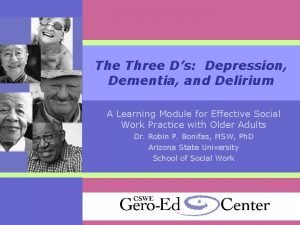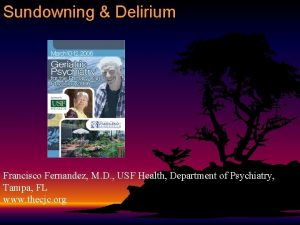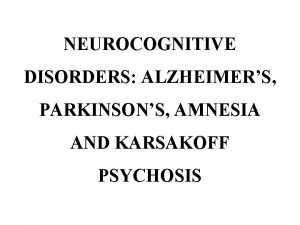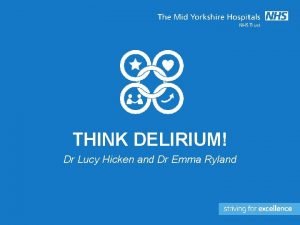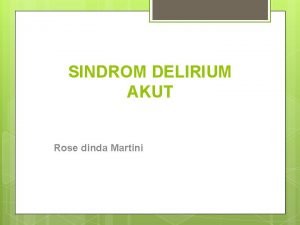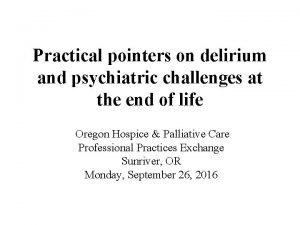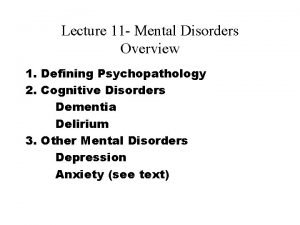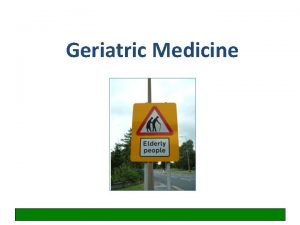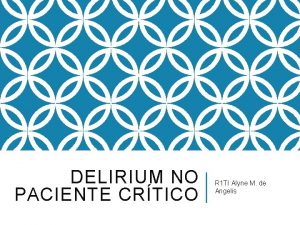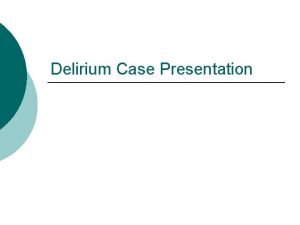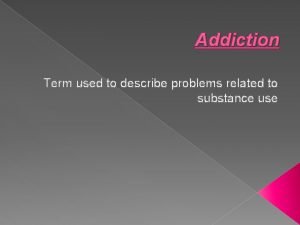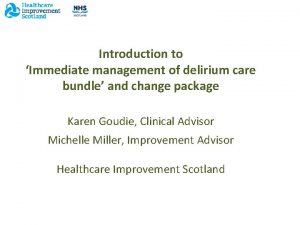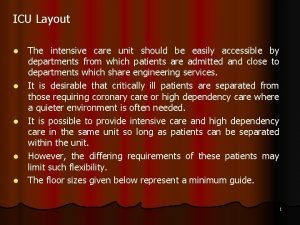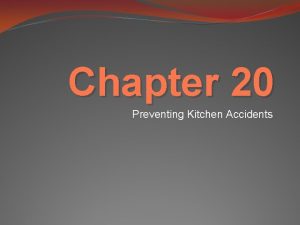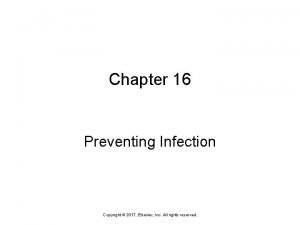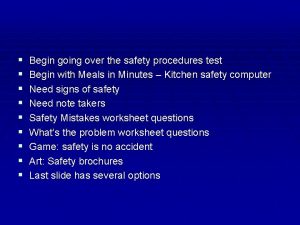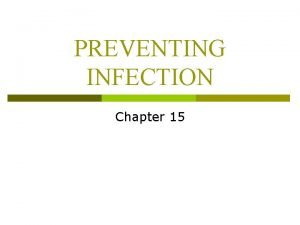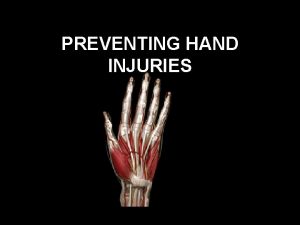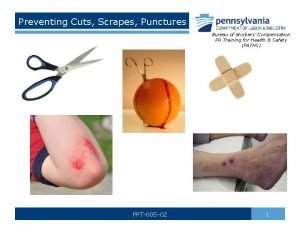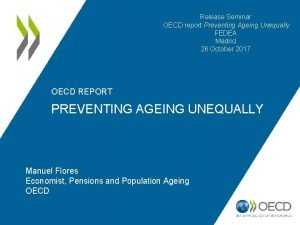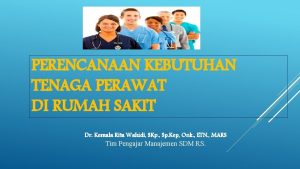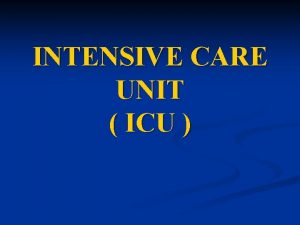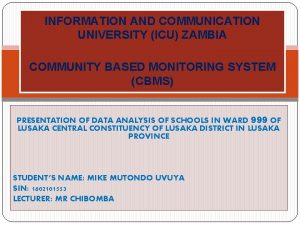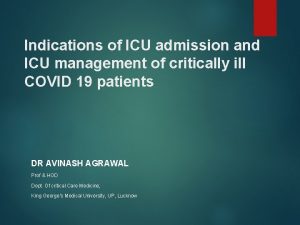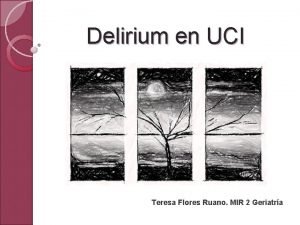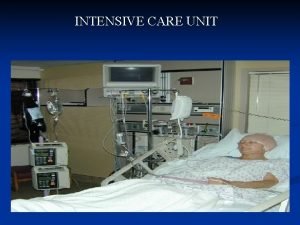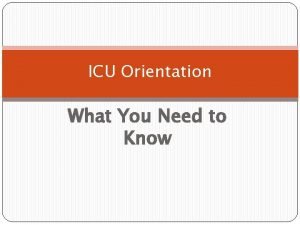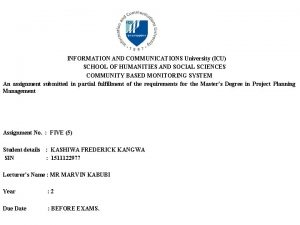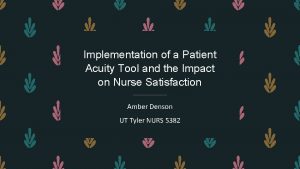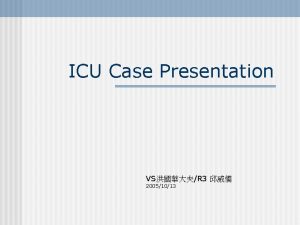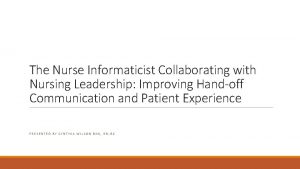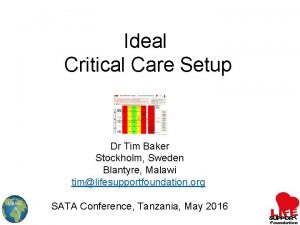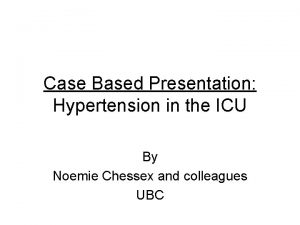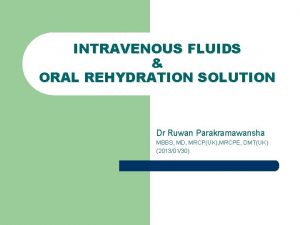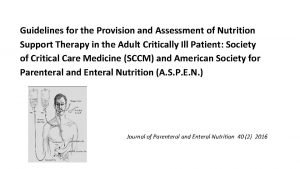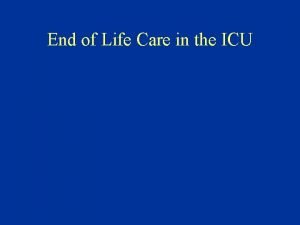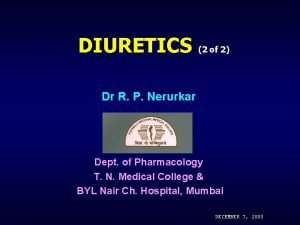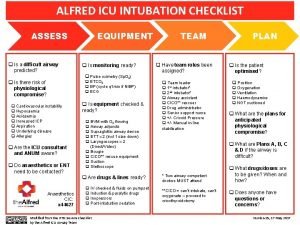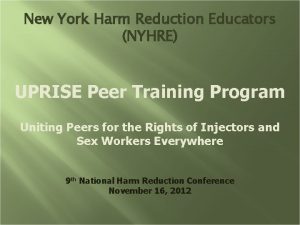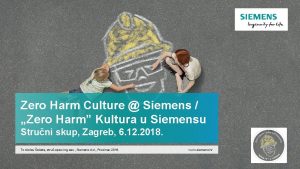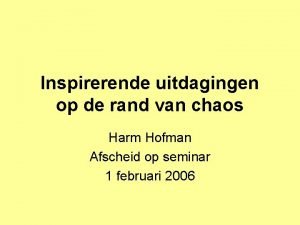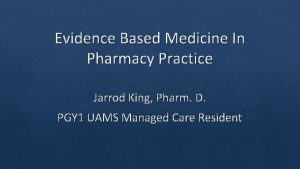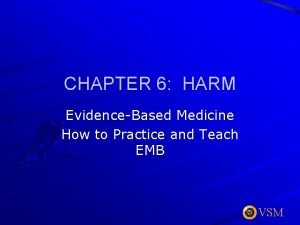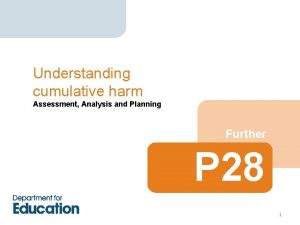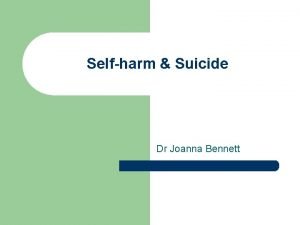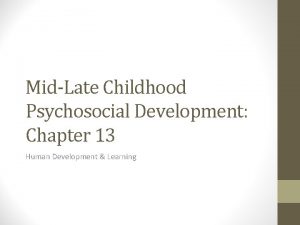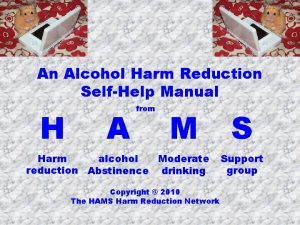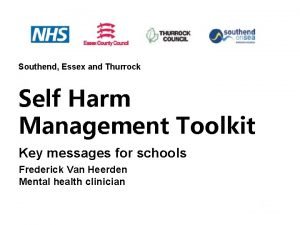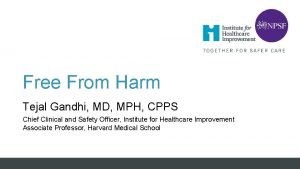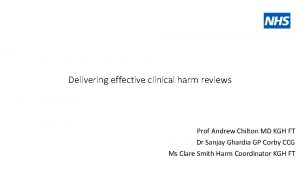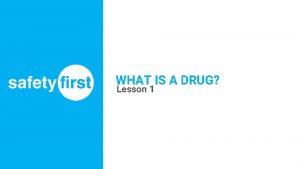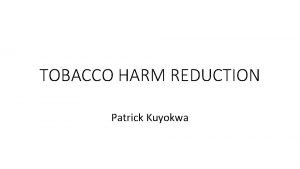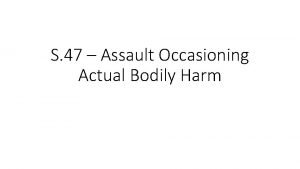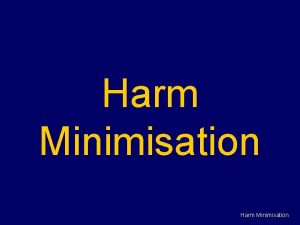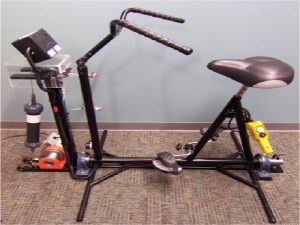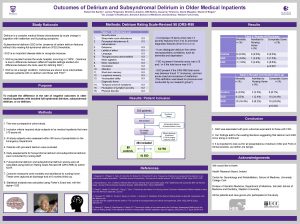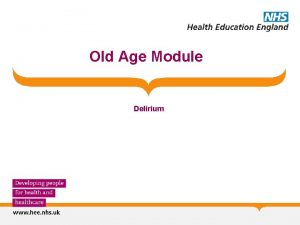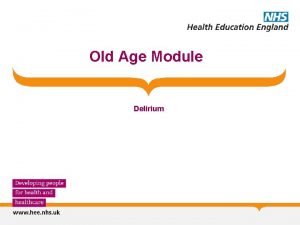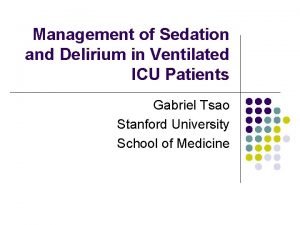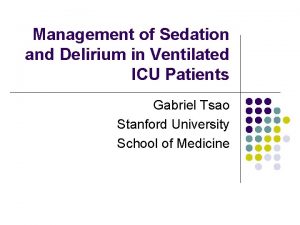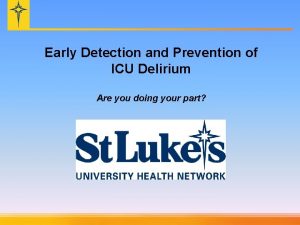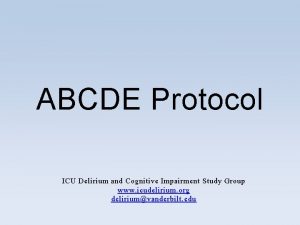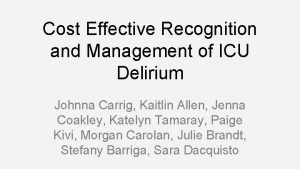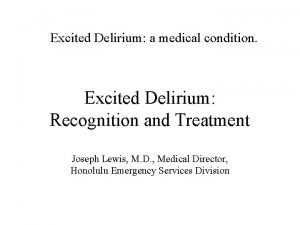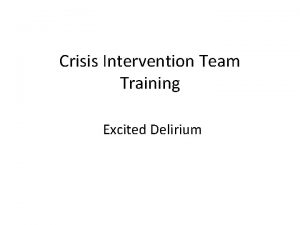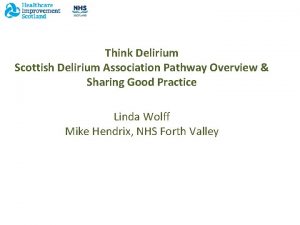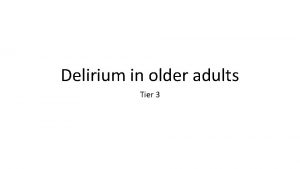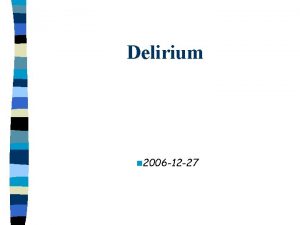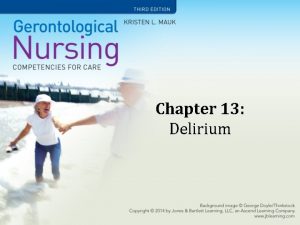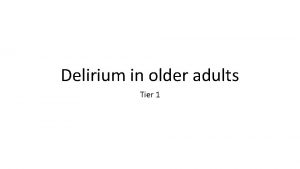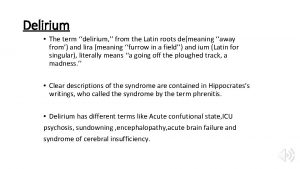Preventing Harm in the ICU Delirium and Poor




































































































- Slides: 100

Preventing Harm in the ICU – Delirium and Poor Functional Outcomes Pat Posa RN, BSN, MSA, CCRN-K, FAAN Quality Excellence Leader St. Joseph Mercy Health System Ann Arbor, MI patposa 07@gmail. com

Disclosures for Pat Posa • Consultant-Michigan Hospital Association Keystone Center • Consultant/Faculty for CUSP for MVP—AHRQ funded national study • Subject matter expert for Sepsis, CAUTI, C-diff, VAE and CLABSI for CMS/HEN 1. 0 & 2. 0 and HIIN • Speaker bureau for ICU Medical

Learning Objectives At the completion of this activity, the participant will be able to: • Define Post ICU Syndrome in the patient and family • Identify current practice through performance of a gap analysis and begin to build the will to reduce cognitive and physical dysfunction harm that occurs during a patient’s ICU stay. • Discussion current evidence based practice that can help reduce PICS & PICS-F

What is it

PICS: Concepts Driving Initiatives Focus on safe transitions and handoffs Critical care is the whole episode of care---not just the ICU Family-centered care Harvey M, Davidson J. Crit Care Med, 2016; 44(2): 381 -385

Quote from husband of 32 year old sepsis survivor “Doctor, she’s not all there. The wit, the comprehension, the concentration. It’s all haphazard at best. To most, it is unrecognizable. The best way to describe it is mental disorganization, like there is a connection missing or a synapse not firing. It has been 10 months, and I just keep waiting for it to straighten itself out. Is this it? ”

Post Intensive Care Syndrome Harvey M, Davidson J. Crit Care Med, 2016; 44(2): 381 -385

Definition PICS is defined as new or worsening impairment in physical, cognitive, or mental health status arising and persisting after hospitalization for critical illness Harvey M, Davidson J. Crit Care Med, 2016; 44(2): 381 -385

http: //www. icudelirium. org/testimonials. html

PICS-Physical Dysfunction • Less than 10% of patients on mechanical ventilation for > 4 d are alive and fully independent 1 yr later • Caregiver assistance ranging from assistance with activities of daily living to full care is required by patients 1 yr later • Half of patients with adult respiratory distress syndrome have not returned to work 1 yr later • ICU-acquired weakness that can persist for years can develop in 25– 80% of those with sepsis or on mechanical ventilation for > 4 d Desai SV, Law TJ, Needham DM: . Crit Care Med 2011; 39: 371– 379 Brummel NE, Balas MC, Morandi A, et al: Crit Care Med 2015; 43: 1265– 1275 Briegel I, Dolch M, Irlbeck M, et al: Anaesthesist 2013; 62: 261– 270

PICS: Cognition & Mental Illness • Cognitive impairment that can persist for years develops in 30– 80% of patients • Symptoms of depression occur 1/3 of patient and persist for a year • Symptoms of anxiety occur in 23– 48% have symptoms of anxiety • Symptoms of posttraumatic distress syndrome occur in 10– 50% of patients and may persist for years Desai SV, Law TJ, Needham DM: . Crit Care Med 2011; 39: 371– 379 Brummel NE, Balas MC, Morandi A, et al: Crit Care Med 2015; 43: 1265– 1275 Briegel I, Dolch M, Irlbeck M, et al: Anaesthesist 2013; 62: 261– 270 Rabiee A, et al. Crit Care Med, 2016, May 5 th online

Post Sepsis Syndrome • People who have suffered from severe sepsis and especially those treated in an intensive care unit are at greatest risk of suffering postsepsis syndrome. • “ 60 percent of hospitalizations for severe sepsis were associated with worsened cognitive and physical function among surviving older adults. The odds of acquiring moderate to severe cognitive impairment were 3. 3 times higher following an episode of sepsis than for other hospitalizations. ” • Sepsis survivors may be more at risk for developing other infections both viral and bacterial Iwashyna, T. JAMA 2010; Mukherjee, S SHOCK 2012

Cognitive Impairment: Sepsis 25 Before Sepsis After Sepsis p<0. 001 20 Mild Cognitive Impairment 15 % survivors cognitively impaired 10 Moderate/Severe Cog Impairment 5 0 -3 years -1 year + 3 years Iwashyna T, JAMA 2010; 304: 1787 -1794

Functional Trajectories by Baseline Functioning 1. 57 new limitations among patients who had no limitations before ADL: walking, dressing, bathing, eating, getting into and out of bed and toileting IADL: preparing a hot meal, shopping for groceries, making telephone calls, taking medicines, and managing money Iwashyna T, JAMA 2010; 304: 1787 -1794

Epidemiology of ICU Delirium • 20 - 80% of ICU patients have delirium during ICU • Frequently unrecognized or misdiagnosed by clinicians • Subtypes: – Hyperactive (agitated, increased motor activity) 1% – Hypoactive (sleepy, inattentive, decreased motor activity) 44% – Mixed 55% • Onset: ICU Day 2 (+/- 2) • Duration: 4 (+/- 2) days • 50% & 10% of ARDS pts delirious at ICU & hospital d/c Ely, EW, et al. JAMA 2001; 286, 2703 -2710 Ely, EW, et al. CCM 2001; 9: 1370 -1379 Peterson, et al JAGS 2006: 54: 479 -484 Mc. Nicoll L, JAGS 2003; 51: 591 -98; Fan, et al CCM 2008: 94 -99.

1 out of 4 cognitive Impairment • Multicenter RCT- medical-surgical ICU’s at 12 • 821 patients with ARF or Shock • Evaluated in-hospital delirium and cognitive impact 3 months Brain-ICU Study -12 months post d/c Results • 74% of patients developed delirium during hospital stay • 1/3 & 1/4 had cognitive scores at 1 year follow-up c/w moderate TBI & mild Alzheimers, respectively • Affected both older and younger Pandharipande, PP. et al. N Engl J Med; 369: 1306: 1316

Lived Experience of ICU in Patients with Delirium “I can’t remember” “fear & safety concerns” “wanting to make a connection” “trying to get it straight” Whitemore K, et al. Am J Crit Care, 2015; 24(6): 474 -479

Delirium and Patient Outcomes • ? Independently associated with increased risk of death: – Each day of delirium increase 1 yr mortality by 10% • • • Duration assoc. with short & long term cognitive impairment 1 out of 4 patients had cognitive impairment at 12 months Mech Vent duration ICU & Hospital Length of Stay Estimated national costs $4 to $16 Billion ? Post-d/c anxiety/ PTSD symptom from delirious memory Klouwenberg BMJ 2014; 349: g 6652; Ely. ICM 2001; 27, 1892 -1900 Ely, JAMA 2004; 291: 1753 -1762 ; Lin, SM CCM 2004; 32: 2254 -2259 Girard CCM 38(7): 1513 -1520; Milbrandt E. , CCM 2004; 32: 955 -962. Jackson. Neuropsychology Review 2004; 14: 87 -98. Oimet ICM 2007; 33: 1007 -1013; Davydow Gen. Hosp. Psych 2008; 30: 421 -434 Pandharipande, PP. et al. N Engl J Med; 369: 1306: 1316

Patient Risk Factors • • • Immobility Number of days on mechanical ventilation Length of stay in the ICU Heavy sedation Delirium Hypoglycemia Hypoxia Sepsis ARDS Desai SV, Law TJ, Needham DM: . Crit Care Med 2011; 39: 371– 379 Brummel NE, Balas MC, Morandi A, et al: Crit Care Med 2015; 43: 1265– 1275 Briegel I, Dolch M, Irlbeck M, et al: Anaesthesist 2013; 62: 261– 270

PICS-F: Psychosocial Challenges • Anxiety is present in 10– 75% of family • Symptoms of posttraumatic distress syndrome occur in 8– 42% of family • Medication for anxiety or depression are required by 33% of family • The above can persist for years • Family members may develop prolonged or complicated grief • Family members may have exacerbation of chronic health conditions • Family dynamics may be challenged • Family financial security may be at risk – A total of 50% of patients require caregiver assistance 1 year later. Davidson JE, Jones C, Bienvenu OJ: Crit Care Med 2012; 40: 618– 624 Netzer G, Sullivan DR: Ann Am Thorac Soc 2014; 11: 435– 441 Jezierska N: Anaesthesiol Intensive Ther 2014; 46: 42– 45 Sullivan DR, Liu X, Corwin DS, et al: Chest 2012; 142: 1440– 1446

The Cost of Surviving ICU Care • • • 50% ICU survivors require long term care 1 31% depleted savings 1 20% reported family had to leave gainful employment 1 Caregiver suppot-17. 4 hours per week 1 Higher 5 year mortality (32. 2% vs 22. 7%)2 Greater hospital resource use define as mean hospital readmission rate (4. 8 vs. 3. 3/person/five years) 2 • Comorbidities/pre-ICU hospitalizations stronger predictor of hospital resource use than acute illness 2 • 51% higher mean 5 year hospital cost ($23, 608 vs 16, 913/patient) 2 • After adjustment for co-founders-resource use persisted 2 1. 2. Iwashyna TJ, et al. Semin Respir Crit Care Med. 2012; 33(4): 327 -338 Lone NI, et al. Am J Resp Crit Care Med 2016 Jan 27

Prevention is Key Minimizing Risk Factors

Reduction of Risk Factors for PICS-F • Family center care programs • Frequent and understandable communication about the patient’s care and condition • Shared decision-making • Early psychologic intervention and support • Family presence and participation in care programs • Caseworker and social worker involvement in care and planning • ICU diaries an education on how to use them • Information on PICS and resources Harvey M, Davidson J. Crit Care Med, 2016; 44(2): 381 -385

Reduction of Risk Factors for PICS • • • ABCDEF bundle Early psychologic intervention ICU diaries Healing environments of care Post-discharge follow-up programs Harvey M, Davidson J. Crit Care Med, 2016; 44(2): 381 -385

“Four Cornerstones for Success” Evidence Based Practice Reduction of Practice Variation Inter. Professional Teams System Collaboration

Blending Priorities Clinical Implementation of PAD guidelines Inter-professional Team Development The ABCDEFGH Bundle for the ICU

A B C D E F G H ASSESS, PREVENT & MANAGE PAIN BOTH SAT & SBT COORDINATION & COMPREHENSIVE ORAL CARE CHOICE OF SEDATION DELIRIUM EARLY MOBILITY FAMILY ENGAGEMENT & EMPOWERMENT/FOLLOW UP REFERRALS/ FUNCTIONAL CHECKLIST GOOD HANDOFF COMMUNICATION HANDOUT MATERIALS FOR PICS & PICS-F Harvey M, Davidson J. Crit Care Med, 2016; 44(2): 381 -385 Balas M, et al. Crit Care Med. 2014 May; 42(5): 1024 -36. www. iculiberation. org

A ASSESS, PREVENT & MANAGE PAIN B BOTH SAT & SBT C CHOICE OF SEDATION D DELIRIUM E EARLY MOBILITY F FAMILY ENGAGEMENT Harvey M, Davidson J. Crit Care Med, 2016; 44(2): 381 -385 Balas M, et al. Crit Care Med. 2014 May; 42(5): 1024 -36. www. iculiberation. org

Pain Agitation and Delirium (PAD) Recommendations • Agitation in critically ill patients may result from inadequately treated pain, anxiety, delirium, and/or ventilator dysynchrony • Detection and treatment of pain, agitation, and delirium should be reassessed often in these patients • Patients should be awake and able to purposely follow commands in order to participate in their care unless a clinical indication for deeper sedation exists Website to help organizations implement the PAD guidelines and reverse immobility: www. iculiberation. org; www. icudelirium. org Barr J. Crit Care Med. 2013; 41: 263 -306

ASSESS, PREVENT & MANAGE PAIN Society of Critical Care Medicine PAD Guidelines 2013 CPOT and BPS most valid and reliable The American Society of Pain Management Nursing July 2011 CPOT is acceptable for the critically ill/unconscious Barr J. Crit Care Med. 2013; 41: 263 -306

Critical Care Pain Observation Tool (CPOT)

ICU Liberation Program based on PAD Guidelines www. iculiberation. org

A ASSESS, PREVENT & MANAGE PAIN B BOTH SAT & SBT C CHOICE OF SEDATION D DELIRIUM E EARLY MOBILITY F FAMILY ENGAGEMENT Harvey M, Davidson J. Crit Care Med, 2016; 44(2): 381 -385 Balas M, et al. Crit Care Med. 2014 May; 42(5): 1024 -36. www. iculiberation. org

ABC Trial (RCT Paired Sedation & Vent Weaning Protocols) Girard, et al, Lancet. 2008; 371: 126 -34

ABC Trail: Mortality at 1 Year Girard, et al, Lancet. 2008; 371: 126 -34

Daily Sedation Interruption Decreases Duration of Mechanical Ventilation • Hold sedation infusion until patient awake, then restart at 50% of prior dose • “Awake” defined as any 3 of the following: – Open eyes in response to voice – Use eyes to follow investigator on request – Squeeze hand on request • Length of MV 4. 9 vs. 7. 3 days (P=0. 004) – Stick out tongue on request • ICU LOS 6. 4 vs. 9. 9 days (P=0. 02) Kress J. N Engl J Med. 2000; 342: 1471 -7. Needham D. Crit Care Med. 2012; 40: 502 -9 www. ICUliberation. org. • Fewer diagnostic tests to assess changes in mental status • No increase in rate of agitated-related complications or episodes of patient-initiated device removal • No increase in PTSD or cardiac ischemia

• Perform the Safety Screen: • Pass safety screen? Turn off all sedatives • Observe for 5 min, cont for up to 4 hrs. • If patient awakens: follow 3 out of 4 commands (open eyes, look at you, squeeze hand, push out tongue) • Leave sedation off! Tell RT so SBT can be completed. Try • The patient fails based on: intermittent dosing or restart at ½ rate

DAILY SBT Process • Coordinate timing with RT • Conduct safety screen – Is the patient on vasopressors? This is not automatic exclusion. Must be a discussion with the medical team. • Pass the safety screen? RT will perform and document SBT and results of SBT. • RT will notify team if patient passes. • Failure of SBT is based on:

CDC Prevention Epicenters Wake Up and Breathe Collaborative • Prospective quality improvement collaborative • Goal: prevent VAEs through less sedation and earlier liberation from mechanical ventilation • Mechanism: increase performance of paired daily spontaneous awakening trials and breathing trials (SATs and SBTs) • 12 ICUs affiliated with 7 hospitals Klompas M. (CDC ABCDE Collaborative) Am J

CDC Prevention Epicenters’ Wake Up and Breathe Collaborative SATs / SBTs VAEs • 63% in SATs • 37% in VACs • 16% in SBTs • 65% in IVACs • 81% in SBTs done with sedatives off • Klompas M. (CDC ABCDE Collaborative) Am J Respir Crit Care Med. 2015; 191: 292 -301.

Outcome of SAT/SBT • • • Decreased days of mechanical ventilation Reduced weaning time Reduced reintubation rates Fewer days with delirium Decreased length of ICU stay Decreased length of hospital stay Ely E. N Engl J Med. 1999; 335: 1864 -9. Girard T. Lancet. 2008; 371: 126 -34. Esteban A. Am J Respir Crit Care Med. 1997; 156: 459 -65. Esteban A. Am J Respir Crit Care Med. 1999; 159: 512 -8 www. ICUliberation. org

Making it Happen: Wake Up & Breathe • Process Measure: Daily audit of SAT/SBT compliance or documentation of contraindication – Determine if they meet SAT criteria – Decrease or stop sedation per protocol – Determine if patient meets Readiness to Wean – Determine if meet SBT protocol criteria – Consider same time daily (sometimes x 2) – Discuss results in multidisciplinary rounds – Include in nurse to nurse handoff/other handoffs – Ventilator LOS posted/Extubation rates posted

Additional Strategies for Success • Implement non-physician staff driven protocols for daily SBT/SAT • Protocols on order sets • Include in both nursing & respiratory flow sheets • Self extubation is slightly higher but reintubation is not. Ely W et al. Chest, 2001; 120(6): 454 s-463 s Brook AD, et al. Crit Care Med, 1999; 27(12): 2824 -2825 Westwall S. Nursing in Critical Care, 2008; 13(4): 203 -207 Abbott CA, et al. Worldviews on Evidence Based Practice, 2006: 139 -152

Interdisciplinary Rounds: Nursing Objective Card Pain, Agitation and Delirium Mobility VAP SEPSIS CAUTI/CLABSI

A ASSESS, PREVENT & MANAGE PAIN B BOTH SAT & SBT C CHOICE OF SEDATION D DELIRIUM E EARLY MOBILITY F FAMILY ENGAGEMENT Harvey M, Davidson J. Crit Care Med, 2016; 44(2): 381 -385 Balas M, et al. Crit Care Med. 2014 May; 42(5): 1024 -36. www. iculiberation. org

Agitation • Avoid deep sedation/coma: – Sedative medications should be titrated to maintain lighter levels of sedation, unless clinically contraindicated. (+1 B) – Use daily awakening or a titrated sedation strategy to maintain patient wakefulness. (1 B) • Choice of sedative: – Non-benzodiazepines may be preferred over benzodiazepines to improve clinical outcomes in mechanically ventilated ICU patients. (+2 B) • Reduction in sedation requirements: – Use of an analgesia-first (i. e. , analog-sedation) strategy is recommended in mechanically ventilated patients. (+ 2 B) Barr J. Crit Care Med. 2013; 41: 263 -306.

Propofol vs. Benzodiazepines Randomized Trial ICU Comparator Superior Ronan et al. 1995 Surgical Midazolam Propofol Chamorro et al. 1996 General Midazolam Propofol Hsiao et al. 1996 Surgical Midazolam Equivalent Kress et al. 1996 Medical Midazolam Propofol Barrientos-Vega et al. 1997 General Midazolam Propofol Searle et al. 1997 Cardiac Midazolam Equivalent Weinbroum et al. 1997 General Midazolam Both Sanchez-Izquierdo-Riera JA, et al. 1998 Trauma Midazolam Propofol Mixed Midazolam Propofol Medical Lorazepam Propofol Hall et al. 2001 Carson et al. 2006 Outcomes improved by propofol: sedation quality, ventilator synchrony, time to awakening, variability of awakening, time to extubation from discontinuation of sedation, overall time to extubation, ventilator days, ICU LOS among survivors, costs of sedation Slide courtesy of Brenda Pun

Dexmedetomidine vs Benzodiazepines Trials with better outcomes with Dex Population Outcome Improved Pandharipande et al/2007 Mixed ICU Riker et al/2009 Mixed ICU Ruokonen et al/2009 Mixed ICU Maldonado et al/2009 Cardiac surgery Esmaoglu et al/2009 Eclampsia More accurate sedation, more delirium/coma-free days Lower prevalence of delirium, earlier extubation Shorter duration of mechanical ventilation Lower incidence and duration of delirium Shorter ICU length of stay Dasta et al/2010 Mixed ICU Lower ICU costs Jakob et al/2012 General ICU Lighter sedation, fewer ventilation days • Trials with better outcomes with Benzo’s = None Ely EW, et al. Chest. 2012; 142(2); 287 -289. Slide courtesy of Brenda Pun

Non-Benzodiazepine Sedative Medications are Associated with Better ICU Outcomes • Systematic review and meta-analysis of 6 RCTs comparing benzodiazepine vs. non-benzodiazepine ICU sedation regimens: – ↓ICU LOS (6 studies) • Difference of 1. 6 days, P= 0. 0007 – ↓ Duration of mechanical ventilation (4 studies) • Difference of 1. 9 days, P< 0. 00001 – Similar delirium prevalence and short-term mortality. Fraser G. Crit Care Med. 2013; 41: S 30 -8 www. ICUliberation. org

Association Between Different Sedatives & Vent Related Outcomes • Single academic center, retrospective analysis of patients mechanically ventilated for greater > three days • 9603 consecutive episodes of mechanical ventilation were evaluated over seven years • Results – Benzodiazepines and propofol were associated with ↑ VAE risk, dexmedetomidine was not – Propofol associated with less time to extubation compared with benzodiazepines. – Dexmedetomidine was associated with less time to extubation compared with benzodiazepines and propofol. (small number) – No difference in hospital discharge or mortality Klompas M, et al. Chest, 2016; 149(6): 1373 -1379

Agitation • Assess q 2 -4 hrs or prn with change in dose or patients condition • Use validated tool (RASS or SAS) • RASS target -1 to +1 • SAS target 3 to 4 www. iculiberation. org


DAYS WITHOUT SEDATION!!!!!!!

A ASSESS, PREVENT & MANAGE PAIN B BOTH SAT & SBT C CHOICE OF SEDATION D DELIRIUM E EARLY MOBILITY F FAMILY ENGAGEMENT Harvey M, Davidson J. Crit Care Med, 2016; 44(2): 381 -385 Balas M, et al. Crit Care Med. 2014 May; 42(5): 1024 -36. www. iculiberation. org

Delirium: First Focus on Prevention • Pain and sedation scores • Analgesia and Sedative Algorithm – Control pain first, then anxiety – Use intermittent meds first before continuous • • Target RASS + 1 to -1 Daily SAT (spontaneous awakening trial) Daily SBT (spontaneous breathing trial) Screen for Delirium---minimum q 12 hrs; can do it more frequently • Implement non-pharmacological strategies

Is anyone home? Check if the lights are on


In Rounds When ICU-CAM is + • When reporting the CAM ICU in rounds, if it is positive the following evaluation should occur. • Dr. Dre – Dr: diseases; diseases that contributes to delirium (sepsis, hypoxia, COPD) – Dr: drug removal; benzodiazepines or any drug interactions that may contribute to delirium – E: environment; nonpharmacological interventions to reduce delirium. This may include reorientation sleep protocol, unrestrained, eyeglasses, hearing aids etc. Courtesy of Dr Wes Ely

Non-Pharmacological Strategies Sleep Promotion • • • Appropriate Medications Bath during day Chair position Lighting Television Hearing/Vision Aids/Dentures Control Noise Ear plugs/eye mask Minimizing care related disruptions Other • Cognitive Stimulation/Music • Reorientation • Familiar objects in room/pictures Mobility Promotion • • • Evaluate for Physical Therapy Range of Motion Sleep Work with PT Spontaneous Awakening Trial Sedation Awakening • Sleep Promotion • Mobility Pandharipande P et al. (Lorazepam) Anesthesiology 2006; 104: 21– 26; Oimet ICM 2007; 33: 1007 -1013; Pandharipande P et al. (Midazolam) J Trauma 2008 Dubois MJ et al. , (Morphine) Intensive Care Med 2001; 27: 1297 Abraha I, et al. Plos One. 2015; DOI: 10. 1371/journal. pone. 0123090 Gathecha E, et al. J of Hosp Med, 2016 online

PAD Treatment of Delirium Recommendations • There is no published evidence that treatment with haloperidol reduces the duration of delirium in adult ICU patients (No Evidence). • Atypical antipsychotics may reduce the duration of delirium in adult ICU patients (C). • We do not recommend administering rivastigmine to reduce the duration of delirium in ICU patients (– 1 B). Barr J, et al. Crit Care Med 2013; 41: 263– 306

Perceptions and Practices Regarding Sleep in the ICU*1 • 1223 surveys of providers – 59% nurses – 39% physicians • 24 countries • 75% indicate ICU patients sleep poor or very poor • 83% to 97% felt poor sleep was associated with negative ICU outcomes ICU noise at 45 d. BA & ½ the time at 54 d. BA 2 • 32% had sleep 1. Kamdar BB, et al. Ann Am Thorac Soc. 2016 Apr 22 promoting protocols The Sleep in the ICU Task Force 2. Presented at Euroanaesthia 2016 accessed 07/14/2016

Perceptions and Practices Regarding Sleep in the ICU Kamdar BB, et al. Ann Am Thorac Soc. 2016 Apr 22 The Sleep in the ICU Task Force

Healing Environments • • • Lighting Color Art Noise reduction Room temperature Use of sensory aids – Glasses & hearing aids • Promote family presence • Sleep Protocols ↓ Delirium & anxiety which contribute to a ↓ in risk of cognitive impairment & PTSD post discharge Salluh JI, et al. BMJ 2015; 350: h 2538 Warlan H et al. Crit Care Nurs. 2015; 35: 44 -52

A ASSESS, PREVENT & MANAGE PAIN B BOTH SAT & SBT C CHOICE OF SEDATION D DELIRIUM E EARLY MOBILITY F FAMILY ENGAGEMENT Harvey M, Davidson J. Crit Care Med, 2016; 44(2): 381 -385 Balas M, et al. Crit Care Med. 2014 May; 42(5): 1024 -36. www. iculiberation. org

Outcomes of Early Mobility Programs • • • incidence of VAP time on the ventilator days of sedation incidence of skin injury delirium ambulatory distance Improved function in hospital readmissions ICU & Hospital LOS Staudinger t, et al. Crit Care Med, 2010; 38. Abroung F, et al. Critical Care, 2011; 15: R 6 Morris PE, et al. Crit Care Med, 2008; 36: 2238 -2243 Pohlman MC, et al. Crit Care Med, 2010; 38: 2089 -2094 Schweickert WD, et al. Lancet, 373(9678): 1874 -82. Thomsen GE, et al. CCM 2008; 36; 1119 -1124 Winkelman C et al, CCN, 2010; 30: 36 -60 Azuh O, et al. The American Journal of Medicine, 2016, doi: 10. 106/jmjmed. 2016. 032 Corcoran JR, et al. PMR J, 2016 in press

Early Physical and Occupational Therapy in Mechanically Ventilated Patients • Prospective randomized controlled trial from 2005 -2007 • 1161 screen, 104 patients mechanically ventilated < 72 hrs, functionally independent at baseline met criteria • Randomized to: – early exercise of mobilization during periods of daily interruption of sedation (49 pts) – daily interruption of sedation with therapy as ordered by the primary care team (55 pts) • Primary endpoint: number of patients returning to independent functional status at hospital discharge able to perform activities of daily living and walk (independently) Schweickert WD, et al. Lancet, 373(9678): 1874 -82.

Early Physical and Occupational Therapy in Mechanically Ventilated Patients Schweickert WD, et al. Lancet, 373(9678): 1874 -82

Better outcomes Schweickert et al, Lancet 2009; 373: 1874 -82

Systematic Review of Early Rehabilitation in the ICU • 14 studies/1753 patients • 880 patients in intervention group • 873 patient in control group • Varying methodologies • Results – No difference in short or long term mortality Tipping CJ, et al. ICM, 2017; 43: 171 -183

Systematic Review of Early Rehabilitation in the ICU • Results of Active Rehab – ↑ muscle mass at ICU d/c – ↑ probability of walking without assistance at hospital d/c – ↑ more days alive and out of hospital 180 days • Limitations – Variation in dosage, small sample sizes of individual studies Tipping CJ, et al. ICM, 2017; 43: 171 -183

International Survey of Early Mobilization Practices: Where Do We Stand • Surveyed directors of medical and mixed medical surgical ICUs in 4 countries • Institutions selected a random • Results • 951 ICUs (US 500; France 151, UK 150, Germany 150)/response rate 64% • Staffing models of RN/patient and Physiotherapist differ by country France Germany UK US % EM practice 40% 59% 52% 45% % EM protocol 24% 30% 20% 30% • Factors associated with EM practice • • • presence of multidisciplinary rounds setting daily goals Presence of a dedicated physiotherapist Nurse patient ratio Sedation protocol Bakhru RN, et al. Ann Am Thorac Sur, 2016 Sep; 13(9): 1527 -37.

Consensus on Safe Criteria for Active Mobilization • Systematic review performed than 23 international experts gather to reach consensus Categories • • Respiratory Cardiovascular Neurological Other Considerations Consensus reach on all criteria. If no other contraindications; vasoactives, endotracheal tube, FIO 2 < 60% with Sa. O 2 90% & RR < 30/min were considered safe criteria Hodgson CL, et. al Critical Care, 2014; 18: 658

Mobility Protocol Safety Screen Adapted from AACN mobility to

Mobility Protocol Adapted from AACN mobility

Early Mobility: Can We Do It? Is it Safe?

Safety • > 1 % adverse events during 1449 sitting, standing and walking sessions with patients on ventilators. • Impact of safety of therapy intervention in a single center (routine care) between 2009 -2011 – 1787 admission of at least 24 hrs – 1110 participated in 5267 PT sessions (1 -3 days from admission) – 10 different therapist on 4580 days • Results: − Physiological abnormalities: 34 session (0. 6%) − − − Arrhythmias: 10 occurrences (0. 2%) MAP > 140: 8 occurrences (0. 2%) MAP < 55: 5 occurrences (0. 1%) Oxygen desaturation: 4 occurrences (0. 8%) Falls: 3 occurrences (0. 6%) 1 chest tube, feeding tube and arterial line Bailey P, et al. Crit care Med, 2007; 35: 139 -145 Sricharoenchai T, et al. J of Crit Care, 2104; 29: 395400

Out of Bed Technology

Ambulation Assist Devices

It Takes a Village For Sustainability 1. Necessary Components for Early Rehab • • • Buy-in Multiple disciplines Team communication Opinion leader Individual discipline champion Dedicated rehab personnel Equipment Sedation practice Administrative funding 2. Implementation Strategies • Team center approach • Staff education • Strength & quality of evidence 3. Perceived Barriers • Increase workload • Safety concerns 4. Positive Outcomes • • Improved patient outcomes Staff satisfaction Changed culture Financial savings Eakin MN, et al. J of Crit Care, 2015; 30: 698 -704

A ASSESS, PREVENT & MANAGE PAIN B BOTH SAT & SBT C CHOICE OF SEDATION D DELIRIUM E EARLY MOBILITY F FAMILY ENGAGEMENT Harvey M, Davidson J. Crit Care Med, 2016; 44(2): 381 -385 Balas M, et al. Crit Care Med. 2014 May; 42(5): 1024 -36. www. iculiberation. org

F Family Engagement and Empowerment Good communication with the family is critical at every step of a patient’s clinical course, and empowering the family to be part of the team to ensure best care is adhered to diligently will improve many aspects of the patient’s experience. The F was recently added to help to keep patients and families as the center and focus of care. www. icudelirium. org

Families are the heart of patient-centered 82

“I have learned that people will forget what you said, people will forget what you did, but people will never forget how you made them feel. ” Maya Angelou

Functional Reconciliation/ Follow Up Referrals • Used to describe and keep track of progress in the patient’s physical, cognitive and mental status • Helps to facilitate communication across the continuum of care • Begins with an assessment of patient’s status prior to admission and follows them through the recovery • Believed to be useful but has not been studied yet Harvey M, Davidson J. Crit Care Med, 2016; 44(2): 381 -385 Elliott D, et al Crit Care Med, 2014; 42(12): 2519 -2526

ICU Diaries • Used routinely in Europe • Diaries are kept by families and staff to describe the patients experience during the ICU stay • Pictures are sometimes included • When read post discharge diaries can fill in memory gaps, replace false memories and delusions Outcomes of ICU Diaries: • Decrease anxiety, depression and PTSD symptoms • Decrease PTSD symptoms in families Ullman AJ, et al. Cochrane Database Syst Rev, 2014; 12: CD 010468 Garrouste-Orgeas M, et al. Crit Care Med, 2012; 40: 2033 -2040 Jones C, et al. Am J Crit Care, 2012; 21: 172 -176

Early Psychologic Intervention • Psychologists as members of the critical care team • Early patient & family support, counseling and education on stress management and coping skills • Psychologist involvement has shown to cut the prevalence of anxiety, depression and PTSD in half Peris A , et al. Crit Care, 2011; 15: R 41 Czerwonka Al, et al. J Crit Care 2015; 30: 242 -249 Petrinec AM, et al. Crit Care Med, 2015; 43: 1205 -1212

Handout materials on PICS Self help rehabilitation manual showed ↓ In PTSD symptoms Jones C, et al. Crit Care Med, 2003; 31: 2456 -2461

First US Post ICU Clinics- Indiana University & Vanderbilt • Critical Care Recovery Center at Indiana University (2011) • ICU recovery Center at Vanderbilt (2012) – Team consists of medical ICU nurse practitioner, a pharmacist, pulmonary intensivists, a case manager and neurocognitive psychologist – Any member of the ICU teams can make a referral for patients to the clinic – Screening for inclusion and exclusion criteria are performed – Exclusion criteria • Pre-existing dementia or cognitive defect, life limiting illness, manage primarily by different subspecialty service/eg. liver/renal transplant, already have specialty resources (eg. Stroke or cardiac rehab, long-term resident of a skilled nursing facility – Initial visit: completes spirometry & a 6 minute walk test – Nurse practitioner completes a detailed history and physical exam – Neuropsychologist meets with the patient to evaluate and screen for cognitive impairment and PTSD, anxiety and depression – Only anecdotal data to date Huggins EL, AACN Advances in Critical Care. 2016; 27(2): 204 -211

Barriers to Post Hospital D/C Rehabilitation Programs The early outcome research on these programs has not demonstrated significant benefit. (Harvey M, Davidson J. Crit Care Med, 2016; 44(2): 381 -385 Cuthbertson BH, et al. BMJ, 2009; 339: b 3723) Connolly B, et al. BMJ Open, 2014; 4: e 004963

SCCM Program Every year, millions of Americans survive critical illness; but despite the efforts of their ICU, many are left with ongoing problems. The current health care system often does not meet the needs of these survivors, or their families, during their weeks to years of recovery. SCCM seeks to improve patient and family support after critical illness through the THRIVE Initiative. Survivors as partners in Professional Societies Educating non-ICU Clinicians RE Survivorship https: //www. youtube. com/watch? v=a. Mn 8 Yd 2 JIn. I https: //www. youtube. com/watch? v=DU 7 Ax-xa. Diw https: //www. youtube. com/watch? v=Rwch 2_9 m. SQA&inde x=1&list=PLsb 8 sp 1 za. JWoe. Z 2 q. Y 2 L_ymyinpn 671 HS 8 Network of In-Person Support Groups Advancing Research & Improving our Own Practice Online Support Groups TJ Iwashya presented at SCCM Congress 2016 Orlando Fl

THE OUTCOME

ABCDE Bundle Reduces Ventilation, Delirium & OOB • Eighteen-month, prospective, cohort, before-after study • 5 adult ICU’s, 1 step down, 1 oncology unit • Compared 296 patients (146 pre-bundle) & 150 post bundle) • Intervention: ABCDE • Measured: – For mechanical ventilation patients (187) examined ventilator free days – All patients examined incidence of delirium, mortality, time to discharge and compliance with the bundle Balas M, et al. Crit Care Med. 2014 May; 42(5): 1024 -36.

Delirium risk ↓from 62. 3% to 48. 7% & 17% less time spent delirious Balas M, et al. Crit Care Med. 2014 May; 42(5): 1024 -36.

Keystones ABCDE Bundle Implementation • 51 hospitals in Michigan’s Keystone ICU initiative • Those implementing SATs and delirium screening were 3. 5 times more likely to exercise ventilated patients • Incomplete or nonsequential bundle implementation yielded lower success rates • Authors wrote, “Another layer of evidence that for the ABCDEs, the whole is greater than sum of the parts. ” Miller M. Ann Am Thorac Soc. 2015; 12: 1066 -71.

ABCDE QI Contextual Study Quality Improvement Project • 4 ICUs • Implemented nearly all elements of the ABCDE bundle w/in the 12 -month time frame. Results: • SATs compliance increased (25% 81%) • SBTs compliance increased (30% 67%) • Delirium Assessment increased (0% 65%) • ¾ ICUs have implemented an early mobility program • 82% received some form of mobility • 49% getting out of bed at least once per day Carrothers, K. Crit Care Med 2013; 41: S 128–S 135

ABCDEF Bundle: Improving Survival & Reducing Brain Dysfunction • Ventilated and non-ventilated medical and surgical ICU patients enrolled between January 1, 2014, and December 31, 2014 • Determine association between ABCDEF bundle compliance/total & partial & outcomes of hospital survival and delirium-free and coma-free days/ adjusting for age, severity of illness, and presence of mechanical ventilation • Patients experienced more days alive and free of delirium and coma with both total bundle compliance (incident rate ratio, 1. 02; 95% CI, 1. 01– 1. 04; p = 0. 004) and partial bundle compliance (incident rate ratio, 1. 15; 95% CI, 1. 09– 1. 22; p < 0. 001). Barnes-Daly, CCM 2017 10% ↑ in total bundle compliance, patients had a 7% higher odds of hospital survival

In Summary • Critical illness and sepsis is catabolic and depleting, rapidly and potentially lasting for years • A prolonged ICU stay can cause delirium and cognitive changes for most patients • Mobility combined with minimal or no sedation started at the beginning of an ICU stay is protective and preventative • Approach the task with structured QI project, collaboration, barrier identification • Implement the ABCDEF Bundle in your ICU today

Questions? 98

Resources Website Selected information available at the site www. sepsisalliance. org signs/symptoms of sepsis description of common sequelae over 400 “Faces of Sepsis” – written tributes to lost loved ones and stories of survivors www. myicucare. org/thrive several white-board videos for patient an families, including videos on preparing for hospital discharge after critical illness, post-intensive care syndrome, and wellness after critical illness information on virtual and in-person peer support groups for critical illness survivors www. icusteps. org information on in-person support groups in the United Kingdom informational pamphlets for patients and families, including a guide to the ICU www. healthtalk. org video interviews describing patient and family experiences of the ICU www. icudelirium. org/patients information about common sequelae of critical illness, including patient testimonials information about the Vanderbilt ICU recovery center

“QUALITY IS NEVER AN ACCIDENT. IT REPRESENTS “ THE WISE CHOICE OF MANY ALTERNATIVES. ” Willa Foster
 Difference between dementia and delirium
Difference between dementia and delirium Difference between delirium and dementia ppt
Difference between delirium and dementia ppt Difference between delirium and dementia table
Difference between delirium and dementia table Lucie big delirium
Lucie big delirium Sindrom delirium akut
Sindrom delirium akut Nash delirium
Nash delirium Terminalt delirium
Terminalt delirium Cam icu escala
Cam icu escala Delirium care pathways
Delirium care pathways Acute confusion related to
Acute confusion related to Delirium definition
Delirium definition Excited delirium перевод
Excited delirium перевод Escala rass
Escala rass Delirium case presentation
Delirium case presentation Flocculation delirium
Flocculation delirium Gcs normal
Gcs normal Driver diagram palliative care
Driver diagram palliative care Chapter 24 lesson 2 preventing and treating stds
Chapter 24 lesson 2 preventing and treating stds Chapter 9 lesson 2 resolving conflicts
Chapter 9 lesson 2 resolving conflicts Chapter 14:3 observing fire safety
Chapter 14:3 observing fire safety Chapter 9 resolving conflicts and preventing violence
Chapter 9 resolving conflicts and preventing violence Chapter 13:2 preventing accidents and injuries
Chapter 13:2 preventing accidents and injuries Icu layout and design
Icu layout and design Chapter 20 preventing kitchen accidents
Chapter 20 preventing kitchen accidents Chapter 16 preventing infection
Chapter 16 preventing infection Preventing kitchen accidents worksheet
Preventing kitchen accidents worksheet Advantages of johannes volkelt empathy theory
Advantages of johannes volkelt empathy theory Chapter 4 preventing injuries through fitness
Chapter 4 preventing injuries through fitness Chapter 15 preventing infection
Chapter 15 preventing infection Preventing hand injuries
Preventing hand injuries Workers compensation puncture
Workers compensation puncture Preventing ageing unequally
Preventing ageing unequally Which is mainly responsible for preventing erosion
Which is mainly responsible for preventing erosion To minimize globalization's harm and reap its benefits
To minimize globalization's harm and reap its benefits Famous lines of macbeth
Famous lines of macbeth Rumus perhitungan tenaga perawat menurut depkes 2005
Rumus perhitungan tenaga perawat menurut depkes 2005 Sedacin
Sedacin Icu localization
Icu localization Klasifikasi pelayanan icu
Klasifikasi pelayanan icu Information and communications university zambia
Information and communications university zambia Icu indication
Icu indication Sean forsythe
Sean forsythe Escala del estado de conciencia
Escala del estado de conciencia Cam icu
Cam icu Cam icu escala
Cam icu escala Kanisha belt
Kanisha belt Cam icu
Cam icu Icu unit meaning
Icu unit meaning Icu orientation
Icu orientation Critical care for dummies
Critical care for dummies Information and communications university
Information and communications university Patient acuity tool
Patient acuity tool Icu library
Icu library Icu case presentation
Icu case presentation Icu case presentation
Icu case presentation Icu transliterator
Icu transliterator Icu medical b3108
Icu medical b3108 Kp icu jpm
Kp icu jpm Ideal icu setup
Ideal icu setup Chatecholamine
Chatecholamine Shanks algorithm example
Shanks algorithm example Carvedilol to iv metoprolol conversion
Carvedilol to iv metoprolol conversion Hypotonic iv solution
Hypotonic iv solution Diet chart for icu patients
Diet chart for icu patients End of life care in icu
End of life care in icu Mannitol uses
Mannitol uses Icu unicode
Icu unicode Icu security group
Icu security group Alfred icu
Alfred icu Advertising help or harm
Advertising help or harm Alcohol harm reduction worksheets
Alcohol harm reduction worksheets Nyhre
Nyhre Absolute risk formula
Absolute risk formula Zero harm culture
Zero harm culture Number needed to harm
Number needed to harm Harm reduction programme
Harm reduction programme Harm hofman
Harm hofman How to calculate number needed to treat
How to calculate number needed to treat Number needed to harm
Number needed to harm Cumulative harm
Cumulative harm Joanna self harm
Joanna self harm Industry versus inferiority
Industry versus inferiority Being legally responsible for causing harm is
Being legally responsible for causing harm is When the dragon wakes what is missing from his treasure
When the dragon wakes what is missing from his treasure Harm reduction worksheets
Harm reduction worksheets Endel härm
Endel härm Self harm toolkit essex
Self harm toolkit essex Wishing evil or harm to others
Wishing evil or harm to others Harm knolle
Harm knolle Hidden harm hazing
Hidden harm hazing Harm van der werf
Harm van der werf Every time
Every time Free from harm report
Free from harm report Clinical harm review
Clinical harm review Harm reduction strategies
Harm reduction strategies Fishermen in the cold sea would not harm
Fishermen in the cold sea would not harm Harm reduction
Harm reduction Difference between abh and gbh
Difference between abh and gbh Abh vs gbh
Abh vs gbh Harm minimisation
Harm minimisation Replace 3. hali
Replace 3. hali
